The Snake Dragon: Between Myth and Reality
Have you ever wondered why dragons reign supreme throughout Fantasy, pop culture and myths? 🤔 These fantastic reptiles are widespread in many cultures via books, television, video games, ... But it did not take Game of Thrones for dragons to become predominant in mythological culture: during the ancient period already, our ancestors venerated and feared dragons.
The incredible popularity of dragons throughout time and culture is due to their proximity to Serpents.
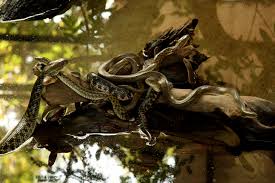
1) Dragon and Serpent
A) Serpent and Dragon: origin of a myth
Serpents and Dragons have always been closely linked. The word "Dragon" comes from the Latin word Draco and the Greek term Drâkon. In ancient Rome, the Draco was a fantastic animal with a serpent's body and a wolf's head. The image of this fantastic beast was used in many Roman emblems 🛡️. In Greek mythology, the Drâkon were giant serpents.
When you think of a creature that looks like a dragon, what is the first that comes to mind? Chances are it is a serpent. Dragons are often depicted with long serpentine bodies and elongated necks. In both cases, the resemblance to snakes is obvious 🔍. Snakes are perfect for creating a terrifying imaginary creature: they have sometimes scary faces, sharp fangs, and on top of that they can be very dangerous.
We have an innate fear of snakes anchored in us, thanks to evolution. But researchers have also identified a very strong fear of snakes in the brains of certain primates such as macaques. This fear of snakes has a very simple reason: if you are afraid of a creature, you will be more careful not to approach it. And if it approaches you, you will quickly run away 💨! This is all the more useful when the creature in question is potentially deadly...
With such an image, it is no wonder that snakes have inspired terrifying Mythical Creatures such as dragons!
B) Western Dragon
While dragons are inspired by snakes in cultures around the world, they do not all take the same form.
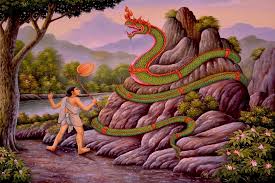
The Western Dragon is distinguished from the Eastern Dragon by several characteristics:
- It has the shape of a reptile (or even a dinosaur), but not necessarily a snake
- Very often it is a Dragon With Wings like those of bats
- It can breathe fire 🔥 and has poisonous breath
- It can strangle large animals with its tail
- The European dragon has 4 legs. If it has 2 it is not a dragon but a Wyvern
- The Western dragon often has large claws, sharp fangs and horns on its head
- Its scales are an impenetrable armor
- The dragons of European stories are powerful, evil and dangerous. They are linked to the element of fire because they can breathe it. In the Christian tradition, dragons can symbolize Satan or sin.
Some nest in caves and guard wonderful Treasures or young princesses 👸 that they have kidnapped. When hungry, they can snatch and devour sheep or cattle that wander too close to their lair. These fantastic reptiles can also eat humans, especially young girls.
Medieval epic poems tell stories of warriors, knights, and wizards who fight cruel and voracious dragons ⚔️ ; in the hope of saving a princess. In some stories, the hero slays the dragon and wins fortune, honor, and the hand of his bride. In others, he fails and is killed or burned.
Even today in European culture, the dragon has remained a powerful symbol of betrayal, as has the serpent. In European folktales, dragons often live deep in caves and caverns filled with precious stones 💎 , in swamps, or in abandoned castles. Some sleep during the day and rampage after dark.
C) Oriental Dragon
The second major type of dragon is the Oriental Dragon, or "Chinese Dragon". Unlike Western dragons, the Asian dragon has a long body very similar to that of snakes 🐉. It still retains 4 legs with sharp claws, fangs and a powerful tail. However, the Chinese dragon is a Wingless Dragon, although it can move by flying.
According to Chinese legends, dragons live at the bottom of seas, rivers, lakes, or any place with water.
The oldest image of the Chinese serpent dragons dates back to the 5th millennium BC! Oriental Dragons are powerful and benevolent symbols, present since the beginning of time in Chinese culture. In the past, dragons were symbols of imperial power and of the emperor himself. They also exercise control over aquatic phenomena, for example calling for rain during a drought. They are therefore associated with the element of water 💧.
Dragons in Asia are considered good and bringer of luck. They are therefore very different from the evil, dangerous and fire-breathing dragons present in most Western stories. Asian Dragons symbolize being lucky, auspicious, powerful and noble 👑. They are not as monstrous as in Western stories, and can also symbolize longevity. However, they remain powerful entities that can be terrible if attacked!
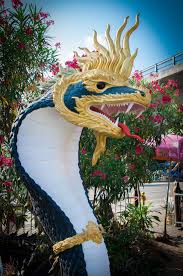
Who is the serpent dragons in Greek mythology?
The snake dragon in Greek mythology is often associated with several serpentine or dragon-like creatures. The most notable among them are:
1. Ladon
-
Role: Ladon was a multi-headed dragon (or serpent) who guarded the golden apples in the Garden of the Hesperides.
-
Description: He was a giant snake with 100 heads, each of which spoke a different language. In some accounts, Ladon is depicted as a dragon, while in others he appears more serpentine.
-
Myth: Ladon was placed in the garden by Hera to prevent anyone from stealing the golden apples, which granted immortality. He was eventually slain by Heracles (Hercules) during his eleventh labor, when he was tasked with retrieving the apples.
-
Symbolism: Ladon is often associated with eternal vigilance and is sometimes seen as a representation of the cosmic or world serpent, symbolizing the boundary between the mortal world and the divine.
2. Python
-
Role: Python was a massive serpent or dragon associated with the Oracle of Delphi.
-
Description: This dragon-like creature was said to reside on Mount Parnassus and guard the Delphic Oracle. Python is often depicted as a large, earth-bound serpent.
-
Myth: According to myth, Python was born from the earth and was tasked with protecting the oracle of Gaia (the Earth goddess). The god Apollo eventually slew Python to claim the oracle for himself, making it one of his primary cult sites.
-
Symbolism: Python represents primal earth forces and chaos, and his defeat by Apollo symbolizes the victory of order, light, and civilization over primal chaos.
3. Typhon
-
Role: Typhon was the most fearsome monster in Greek mythology, often considered a dragon-like figure.
-
Description: Typhon was described as a giant with snake-like legs and the ability to breathe fire. His upper body was humanoid, but his lower half was made of coiling serpents. He also had multiple dragon or snake heads and wings.
-
Myth: Typhon challenged the Olympian gods, especially Zeus, for supremacy over the cosmos. After a fierce battle, Zeus defeated Typhon and buried him under Mount Etna in Sicily.
-
Symbolism: Typhon represents chaos and destruction, the ultimate adversary of the Olympian gods and Zeus' authority.
4. Echidna
-
Role: Known as the "Mother of Monsters," Echidna was part serpent and part woman.
-
Description: She was depicted as a half-woman, half-serpent creature, often described as the mate of Typhon.
-
Myth: Echidna and Typhon together gave birth to many of the most fearsome monsters in Greek mythology, including the Hydra, Cerberus, and the Chimera.
-
Symbolism: Echidna embodies the untamed, primal aspects of nature and motherhood, giving rise to monstrous creatures.
These creatures embody the connection between serpents, chaos, and the forces of nature in Greek mythology, with Typhon and Python being the most closely associated with a dragon or snake-like form.
Dragons are still present everywhere in China today: in ceremonies, festivals, astrology, art, names and lucky charms 🍀. The Chinese very often wear bracelets bearing the image of this wise and fearsome being, like this Chinese Dragon Leather Bracelet.

2) Serpent Dragon in Mythology
Now that you are familiar with Serpent-shaped Dragons, how about we review the most famous and monstrous of all mythologies?
A) Leviathan
Mentioned in the Bible, Leviathan is a fearsome and absolutely titanic primordial being. It ruled over all other creatures of the sea. There are various descriptions of the origins and intent of the creature in history. But most agree that Leviathan is dangerous and capable of wreaking havoc 💀.
Leviathan is known to be a monstrous Sea Serpent, and one of God's original creations. There were several other creatures of equal power that were created, but Leviathan was known to be the most dangerous of them all. Leviathan is depicted in many different ways, but most commonly it takes the form of an absolutely gigantic serpent.
B) The Basilisk Serpent
In European stories, a dragon-like creature known as the Basilisk was sometimes described as a huge serpent born from the corpse of the Gorgon Medusa. Some authors called it the king of serpents 🐍, and claimed that it could kill a man with a single glance by petrifying him, or by injecting him with a deadly venom whose only antidote is a phoenix tear. The Basilisk's gaze was a death trap: once you looked into its eyes, you could no longer look away and your end was sealed... Fortunately, you won't have this little problem with our Basilisk Ring.
The Basilisk is described as a Giant Serpent in Greco-Roman mythology, but it is also described as a mix between a rooster and a snake during the Middle Ages (the Basilicoq 😅).
C) The Lernaean Hydra
The Hydra, also called the Lernaean Hydra, in Greek legend was the offspring of Typhon and Echidna. It was a gigantic water serpent-like monster with nine heads (the number varies), one of which was immortal. The monster haunted the marshes of Lerna, near the city of Argos.
It would regularly emerge from its lair to attack the inhabitants and livestock of Lerna. Anyone who tried to decapitate the Hydra would discover that as soon as one head was cut off, two more heads would emerge from the fresh wound. It was finally Hercules who triumphed over the Hydra during one of his 12 labors 💪.
The dragons of Slavic folklore are very similar to the Hydra: a serpentine body and multiple heads.
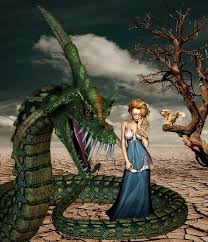
D) Jörmungand
Jörmungand is a giant serpent from Norse mythology, living in the depths of the ocean. It is the largest monster in Scandinavian mythology, and that is no small feat since Norse mythology includes Jotunheim, a kingdom populated by giants! Even the god Thor himself failed to kill the serpent during his fight with the beast 😨.
Jörmungand's name means "earth collar", which is fitting for this serpent. It is so large that it can wrap its body around Midgard (Earth, the domain of mortals) and hold the end of its tail in its mouth in the manner of the Ouroboros. Its mouth, lined with venom-filled teeth, is large enough to swallow a god or a giant.
E) Ladon
Ladon is the titanic dragon that surrounds the trees of the Garden of the Hesperides, and guards the golden apples in ancient Greek mythology. His reptile body is topped with 100 Serpent Heads 🐲, each speaking a different language. This creature is one of the sons of the titans Typhon and Echidna, which explains his enormous size. It was the goddess Hera who entrusted Ladon with the task of guarding this mythical tree.
Ladon is accompanied by the nymphs of the Hesperides in his task. He is not a creature of evil strictly speaking, but is still extremely dangerous. He defends the tree of the Hesperides against any intruder.
Ladon was killed by Heracles in the 11th of his labors, with a poisoned arrow. To reward him for his loyalty, Hera made Ladon ascend to the sky after his death, and he became the constellation of the dragon. 🌌

F) Nìdhögg
Nìdhögg (Old Norse Níðhöggr, literally "He who strikes with malice") is a huge black serpent that gnaws at the third root of the world tree Yggdrasil 🌳. The monster also devours the corpses of murderers and adulterers. In the Norse mythology from which it comes, Nìdhögg intends to bring chaos to the cosmos.
Nìdhögg plays a prominent role in Ragnarök, the end of the world. In a particularly important Scandinavian poem (the Völuspá), Nìdhögg is described as flying out from under Yggdrasil during Ragnarök, probably to help the cause of the giants. Other sources indicate that the appearance of Nìdhögg will mark the end of Ragnarök and that the dragon-serpent will carry away the bodies of the warriors who have perished ☠️. Other sources, on the contrary, maintain that when Nìdhögg leaves its root to tread the soil of Midgard, this will announce the beginning of Ragnarök...
G) Wyverns
The Wyvern is a fantastic creature that is half dragon, half snake. Its name comes from the Latin Viperae ("Viper"). Its reptile body is topped with two bat wings. A Wyvern has only two legs, which is what differentiates it from dragons, which generally have 4.
The legendary Wyvern of Medieval Europe is one of the most aggressive dragons. A Wyvern can breathe fire from its mouth or nostrils and blow a poisonous foul air on its victims 🤢. Its two legs are powerful enough to destroy the cottage of an unlucky villager.
In European Mythology, these dragons are the fierce guardians of a treasure or a hidden gemstone.
H) Python and Apollo
In Greek mythology, Python was a huge dragon-serpent who ruled the oracle of the Delphi region.
According to legend, when the goddess Leto became pregnant with Zeus, she carried the twin gods Artemis and Apollo in her womb. However, Hera, Zeus' wife, was furious when she learned of her husband's infidelity 😡. She ordered Python to chase Leto away, so that she would not give birth anywhere where the sun shines.
Leto was accepted on the newly formed island of Delos, where she gave birth to her twins. When Apollo grew up, he wanted revenge and so pursued the dragon. Python, pursued by Apollo, left Mount Parnassus where he lived and went to Delphi. Apollo found and killed Python 🏹, but Zeus told him that he had to redeem himself because he had committed a sacrilegious act. Apollo therefore founded the famous Pythian Games, in order to purify himself.
I) Bahamut
Bahamut (also called Behemoth) is a creature of a size beyond comprehension, serving as the support of the world in Arabic cosmography (the study of cosmic organization). Alternatively, in Hebrew mythology, he is the largest terrestrial creature ever created 😰. He is currently hiding in the underworld. But according to legends, he will return during the chaos and destruction of the Day of Judgment.
In Arabic mythology, Bahamut is generally described as a half-fish, half-serpent being of Unimaginable Size. Regarding his size, ancient mythology says this: "All the waters of the world, placed in one of his nostrils, would be like a mustard seed in the desert"...
Some myths describe Bahamut as having the head of a hippopotamus or an elephant 🤔. In Hebrew texts, he is given a more monstrous form. It thus appears as a titanic Sea Serpent or a red dragon with sharp limbs and teeth.
According to legend, because of its vanity, objects with its image allowed to keep the eye of this evil serpent away. This is why Nordic warriors adorned themselves with jewelry with its image like this silver Nìdhögg Necklace, in order to go to Valhalla in the event of death on the battlefield (and not end up in the mouth of Nìdhögg!).
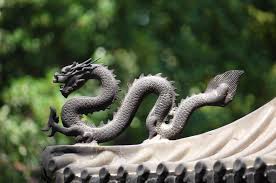
3) A Dragon Snake as a Real Animal
A) A Dragon Snake?
You now know the main dragon snakes in mythology. But did you know that there is such a creature (well almost) very real?
The dragon snake or Dragon Snake (Xenodermus javanicus) is a species of non-venomous Colubrid snake with a strange appearance found in Southeast Asia 🌏. The species is present in several countries including Indonesia, Myanmar, Brunei, Malaysia and Thailand.
The Dragon Snake is most often found in areas close to water or waterways, including forests, marshes, swamps, swamps and especially rice fields.
It is a Semi-Fossorial snake (it digs galleries and can live in them) that spends most of its time underground. These snakes are especially active at night 🌙, to track their prey.
B) A Dragon Scaled Snake
The most remarkable feature of these dragon snakes is their unusual skin. It is made up of 3 rows of "keeled" scales on their backs. These scales look like a cross between a snake and a crocodile 🐊.
It is very easy to see why they are commonly called dragon snakes since their scales are reminiscent of those of dragons .
In addition to their strange look, they also have a strange habit. When touched or picked up, they become stiff, almost like a board.
Dragon snakes are considered rare and are not very often kept as pets because the species does not do well in captivity, and generally does not survive very long. There is very little information and husbandry advice available, so it is probably best to leave them in the wild 👍.
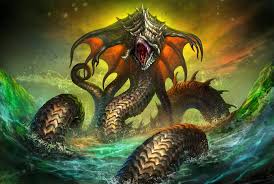
C) The Mystery of the Dragon Snakes
We still know very little about this dragon-scaled snake 😕. Apparently, dragon snakes reach about 70cm in length and are grayish in color. They have a slightly enlarged head and an elongated tail. The species was first described in 1836 by Johannes T. Reinhardt, a Danish zoologist.
The dragon snake belongs to the monotypic genus Xenodermus, which means that it is the only species in this genus, and no subspecies are recognized ❌. The scientific name of the species derives from the Greek words "xeno" meaning strange and "derma" meaning skin, referring to their very strange appearance, at least for a snake.
What is snake dragon in real life?
In real life, the concept of a snake dragon does not refer to any specific biological creature, but it represents a fusion of two real animals—snakes and dragons—both of which have deep cultural, symbolic, and mythological significance across different societies. However, there are a few real-life creatures that might have inspired or resemble what people could describe as "snake dragons":
1. Large Constrictor Snakes
-
Examples: Pythons, Anacondas, and Boa Constrictors.
-
Description: These large, powerful snakes can reach enormous lengths, often over 20 feet (6 meters). Their immense size, ability to overpower large prey, and sometimes menacing appearance might inspire legends of dragon-like creatures.
-
Connection to Dragon Myth: Their serpentine shape and sometimes fearsome reputation make them similar to how dragons are portrayed in many cultures—especially in Eastern mythology, where dragons often have elongated, snake-like bodies.
2. Crocodiles
-
Examples: Nile Crocodile, Saltwater Crocodile.
-
Description: Crocodiles are large, semi-aquatic reptiles with powerful jaws, thick scaly skin, and a dragon-like appearance, particularly in their tails and heads.
-
Connection to Dragon Myth: Ancient people encountering these massive reptiles may have likened them to dragons. In fact, some mythologies refer to creatures resembling crocodiles as dragon-like beasts.
3. Komodo Dragon
-
Scientific Name: Varanus komodoensis
-
Description: The Komodo dragon is the largest living species of lizard and can grow up to 10 feet (3 meters) long. It has a muscular body, sharp claws, and a forked tongue reminiscent of snakes, and it’s capable of taking down large prey, including deer and water buffalo.
-
Connection to Dragon Myth: While it doesn’t fly or breathe fire, the Komodo dragon's size, fearsome nature, and appearance contribute to the idea of a real-life "dragon."
4. Snake-Necked Turtles
-
Examples: Eastern Long-Necked Turtle (Chelodina longicollis).
-
Description: These turtles have long, snake-like necks that can be more than half the length of their bodies, giving them a striking, dragon-like appearance when their necks are fully extended.
-
Connection to Dragon Myth: The combination of a reptilian body and a long, snake-like neck evokes imagery of certain mythical dragon depictions, particularly in Eastern mythology.
5. Dinosaurs and Ancient Reptiles
-
Examples: Mosasaurs, Plesiosaurs, and Pterosaurs.
-
Description: Fossils of giant prehistoric reptiles, like mosasaurs and pterosaurs, may have contributed to the legends of dragons. These creatures, some of which had elongated bodies and wings, could have been misinterpreted as dragons by ancient civilizations discovering their remains.
-
Connection to Dragon Myth: The discovery of massive dinosaur fossils, combined with the inability of early humans to fully understand what these creatures were, may have led to the creation of dragon myths. In fact, some early Chinese scholars who found dinosaur fossils called them "dragon bones."
6. Real-Life Serpent-Like Fish and Eels
-
Examples: Oarfish, Moray Eels.
-
Description: Oarfish are long, ribbon-like fish that can reach lengths of up to 36 feet (11 meters). Their elongated, undulating bodies and dorsal fins give them an appearance similar to mythical sea serpents or dragons. Moray eels also have serpentine bodies and sometimes live in coastal regions, where they may be encountered by humans.
-
Connection to Dragon Myth: When sighted in the ocean, these fish could easily be mistaken for dragon-like sea creatures or mythical serpents due to their long bodies and snake-like swimming movements
While there are no literal "snake dragons" in the real world, certain large reptiles, aquatic creatures, and prehistoric animals likely contributed to the mythology surrounding these mythical beings. Real animals such as pythons, Komodo dragons, and crocodiles possess dragon-like features that, when combined with human imagination and myth-making, form the basis of the snake-dragon concept in various cultures.
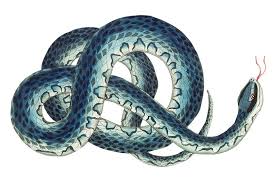
What does snake dragon mean?
A "snake dragon" is a mythical creature that combines the characteristics of a snake and a dragon. It's often depicted as a large, serpentine creature with scales, wings, and possibly horns or claws. The exact appearance and powers of a snake dragon can vary depending on the specific myth or folklore.
The concept of a snake dragon is found in various cultures and mythologies around the world. One of the most famous examples is the Hydra from Greek mythology, a nine-headed serpent that Heracles was tasked with slaying.
What is the snake dragon symbol?
The snake dragon symbol is often represented as a combination of snake and dragon imagery. This can include:
-
Serpentine body: The creature typically has a long, sinuous body similar to a snake.
-
Scales: The body is often covered in scales, like those of a reptile.
-
Wings: Some snake dragons have wings, giving them the ability to fly.
-
Horns or claws: These features can add to the creature's menacing appearance.
-
Multiple heads: The Hydra, a famous snake dragon from Greek mythology, had nine heads.
The specific symbolism associated with the snake dragon can vary depending on the culture or mythology it originates from. However, it is often seen as a symbol of:
-
Power and strength: The snake dragon's large size and formidable appearance make it a symbol of might.
-
Danger and evil: Its association with snakes and dragons often links it to negative forces.
-
Transformation and rebirth: In some cultures, the snake dragon represents the cycle of life and death.
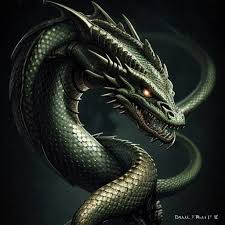
4) Your Snake Label® shop
If you've come this far, it's because just like us you must be a snake enthusiast 🐍! We founded Snake Label® with the aim of showcasing this magnificent animal in everyday life. You can therefore find on our site a wide range of products centered around the theme of snakes:
T-Shirts, Sweatshirts & Sweaters, and Jackets printed in High Definition, with 3D snake heads and patterns
Snake-shaped Rings, Necklaces and Bracelets to add an original touch to your outfit
Pictures and Keyrings bearing the image of this sumptuous animal, ideal for all enthusiasts!
Our collections are constantly growing and we export our products free of charge all over the world!
See you soon on the shop! 😉
Dive into the fascinating world of snakes and explore our other articles now!
Stay Updated!
Don't miss out on the latest insights, tips, and exclusive content. Subscribe to our blog newsletter today and be the first to know about new posts, special offers, and more!
Join our community now—just enter your email below to stay connected.